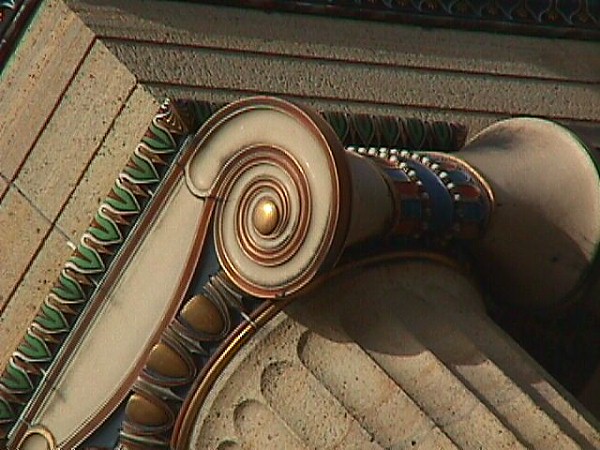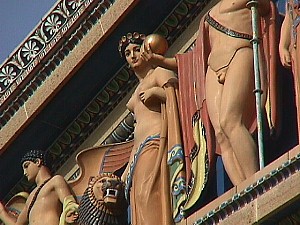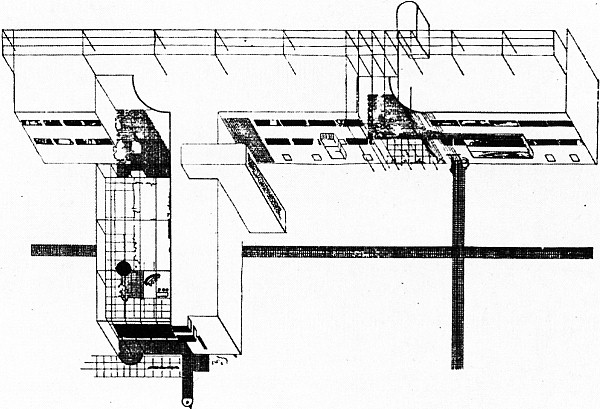Stockholm Public Library 2144
| |
Color Sculpture and Architecture: Philadelphia Revives the Ancient Art of Greek Polychrome
Color was a vital factor in the art of ancient Greece. Vivid, primary colors were as important as form in its beauty. The Greeks interpreted architecture as the skillful combination of form and color. The invariably introduced color into their work. It was not a minor detail, infrequently used, as is generally assumed. Both their buildings and their sculpture were decorated with color. It is now conceded, after years of discussion, that there were evidences of color on the famous Elgin marbles of the Parthenon.
Although classical Greek architecture has flourished, the importance of color in relation to it has been ignored to such an extent that we have come to accept the monochrome treatment as the pure classical style. For this reason Philadelphia's attempt to revive Greek polychrome architecture and sculpture is looked upon as an audacious undertaking by the conservatives in art circles, and the architects, C. L. Borie, Jr., Horace Trumbauer and C.C. Zantzinger, designers of the new Museum of Art in Fairmount Park, are looked upon as pioneers. C. Paul Jennewein and John Gregory, sculptors, and Leon V. Solon, polychromist, are sharing the limelight focused on the builders of the museum.
In making the statement that the museum represents the first serious attempt to revive Greek polychrome treatment Mr. Solon, a recognized authority on polychromy, did not overlook the attempts that have been made to introduce color in buildings, particularly some of our modern skyscrapers. But he does not take these attempts seriously, inasmuch as the results show no evidence of comprehension of decorative capacities in the means that have been employed. "Color is a dangerous thing to use," he warns. It is a science to know which way colors will affect the proportion of ornament. Colors expand and contract the apparent size of areas.

Up to the present the Philadelphia Museum represents the first attempt to use terra cotta for serious sculptural purposes. Sculptured figures for the pediments as well as the architectural detail and roof tiles are of terra cotta. It is the first time that free standing sculpture has been baked in terra cotta to decorate a building, and it was necessary to build special kilns and revise the normal procedure to meet the conditions.
Besides the polychrome ornamentation there will be three main pediments with sculptured figures in polychrome. The pediments for the East and West pavilions have been completed by John Gregory and C. Paul Jennewein, sculptors, in collaboration with Mr. Solon. Mr. Jennewein is also responsible for the architectural modeling and the center and corner figure ornaments in gilt-bronze.
The building is not a copy of any Greek building, nor are the pediments or figure groups copies of Greek works. They are true to the Greek tradition in the use of color and detail but are entirely original in conception. As such, the museum unquestionably will be an important and beautiful contribution to the world's architectural creations.
Exhaustive research convinced Mr. Solon that the use of color was a highly organized art with the Greeks. They always applied color to certain parts of buildings. It was never used on any important feature that performed the function of supporting the building, such as an exterior wall or the shaft of a column, but was confined to the decorative features. Capitals of columns were decorated, but the shafts or bases never. Although the Greek principle was absolutely adhered to in the Philadelphia Museum certain deviations from Greek practice were necessitated by existing conditions. For instance, the range of observation in Greece is small, whereas the museum will be viewed from long range. Through much experimentation and closest possible cooperation between sculptors and polychomist highly satisfactory results have been evolved at Fairmount Park. In some cases sculptural detail had to be revised to facilitate distribution of color. Only brilliant colors were used on account of their visibility at long range. These colors had to be interrelated, one figure to another and carefully spaced throughout the whole group.
 
When questioned about the modeling of features Mr. Gregory stated that polychrome sculpture demands that faces be modeled like masks and depend upon color for expression and characteristics. The use of color in sculpture demands flat surfaces. Detail otherwise brought out by modeling is provided by color in polychrome sculpture. He found that the most important thing he had to keep in mind was to work in vertical planes in order to eliminate shadows, inasmuch as the color would be affected by dark shadows.
"The East" demanded, of course, more colorful treatment than "The West," represented by Mr. Jennewein's pediment group for the West Pavilion. The dark-skinned figures of "The East" demanded also the predominating use of a deep ivory tone in the draperies to carry out the harmony with the building material, a matter of vital importance. "Kato" stone was selected for the exterior because of its golden-orange tone clouded with silver-gray, which offers an ideal background for the brilliant colors used in the decorations. It is much warmer in tone than ordinary sandstone.
In giving an interpretation of his group, Mr. Jennewein explained that he based his theme on sacred and profane love, the two great underlying forces behind the development of Western art and civilization.
According to the sculptors one of the problems that demand careful working out was the arrangement of patterns that would permit natural divisions for the cutting of figures so that the joining would not mar the effect. The use of terra cotta imposed a three-foot length, and the central figures, which are to be eleven and one-half feet high, will be in four sections.
Roof tiles of terra cotta, measuring approximately three feet square, also carry out the polychrome effect. They are a grayish blue glaze on the face, with a dark blue edge, so that the coloring of the roof deepens with the foreshortening of the tiles as the building is approached. The beauty of the roof is enhanced by the varying colors of the sky, which are reflected in the surface of the tiles.
In discussing the treatment of polychrome Mr. Solon said that Greek processes would not serve in the American climate, so terra cotta was chosen because of its durability and the availability of all the colors needed.
Anne Lee, "Color Sculpture and Architecture: Philadelphia Revives the Ancient Art of Greek Polychrome" in The Mentor (May 1928) pp. 41-44.
| |

Ivan Leonidov, Competition Design for the Kazakhstan Government House (Almaty, Kazakhstan, 1927-28).
|